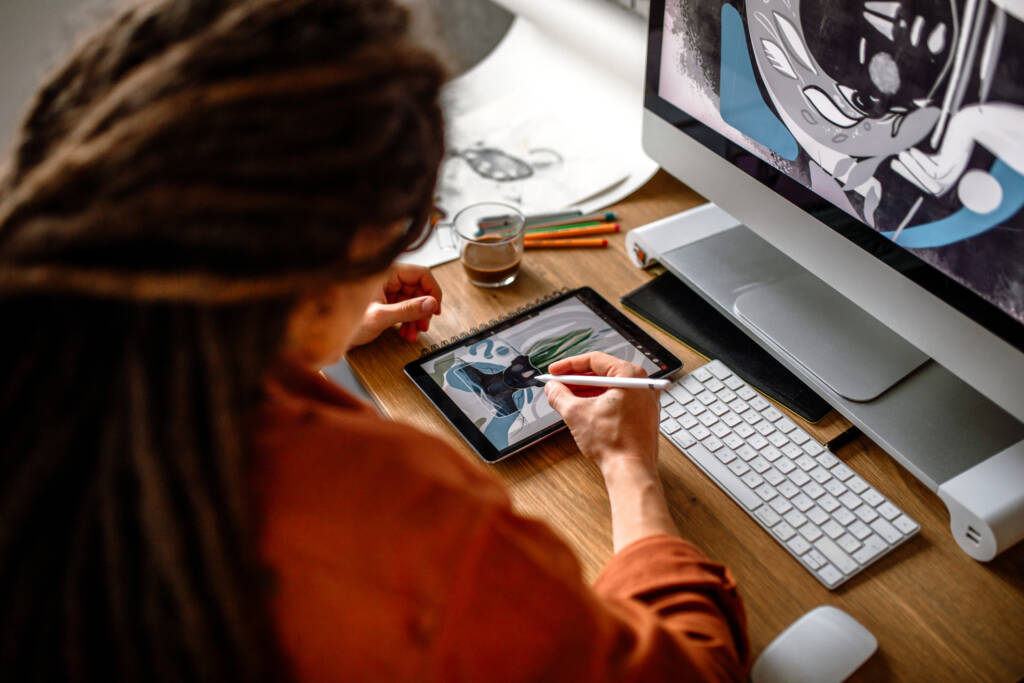
Digital Design 1a

It takes skill to balance composition, cleverly use white space, and arrange visuals to effortlessly communicate with the eyes. If you are drawn to the idea of creating graphic elements, then a career in digital design may be for you! In this course, you will learn the basic principles of design while using the tools needed to succeed in the industry. You will design objects for specific purposes and audiences as well as how to work with and focus on the client. You’ll also explore how to market yourself and open your own design business all while building a portfolio of your work samples. Let’s align your skills and dreams today for a career in digital design!
During this course, you will learn career-related skills and earn a badge for this accomplishment. A badge is a digital certification of your career-related learning that you can share on social media or with higher education platforms, colleges, potential employers, peers, and colleagues. Select this link to learn more about badges.
Major Topics and Concepts
Unit 1: What is Graphic Design?
- Define graphic design and describe how it has developed as a field
- Outline the ways in which technology shapes the field of graphic design
- Explain why graphic design is inseparable from its cultural environment
Unit 2: Careers in Graphic Design
- Categorize several types of graphic design careers
- Identify the skills, education, and experience necessary for graphic design careers
- Explain how student professional organizations can help you prepare for design careers
Unit 3: Skills for Success
- Define foundational computer-related terms
- Describe methods for the effective naming and organization of files
- Articulate foundational concepts for creating, storing, and distributing digital images and text files
- Explain best practices for professional written communication skills
Unit 4: Finding the Right Tools
- Describe the difference between raster- and vector-based software and how raster-based software is used in graphic design
- Explain how vector-based software platforms are used in graphic design and digital publishing
- Identify industry-standard UX/UI design software and its functionality for creating interface designs
Unit 5: Graphic Design Basics
- Define the elements of design (line, space, shape, texture, form, value, and color)
- Identify and apply the principles of design (emphasis, movement, balance, variety, rule of thirds)
- Articulate the elements of an effective design portfolio and apply the principles of design to create one
Unit 6: Print Design
- Describe the work of print designers and apply the principles of effective design to various print layouts
- Identify the elements of document design and describe how to use them effectively
- Explain the various printing processes used for commercial print jobs
Unit 7: The Art of Typography
- Demonstrate knowledge of typographic terminology and the anatomy of letters
- Describe the history, classification, characteristics, and psychology of the serif and sans serif typeface families
- Apply design principles to typography
Unit 8: Understanding Color
- Define the characteristics of color and how we perceive it
- Explain color theory and apply color harmonies to create effective designs
- Identify the most often used color formats, explain how they differ, and choose the appropriate format for your design context
Course Materials
Physical
- Audio recording device
- Paper and pens
- Camera
- Large potato
- A carving tool
- Paper towel
- Ink (could be a stamp pad) or paint (any type) and paintbrush
- Substrate: paper, t-shirt, or any smooth and printable surface
- Printer
Software
- Presentation software
- Word processing software
- Vector editing software
- Website-building and hosting platform
- Web-based drawing software (such as Google Drawings)
- Photo editing software
- Digital design software
- Canva’s Color Wheel or Adobe’s Color Wheel
Competencies
Graphic Design
Students will demonstrate an understanding of graphic design by summarizing the history of graphic design, describing the effects of technology on graphic design, and explaining how graphic design affects culture.
Careers in Graphic Design
Students will demonstrate an understanding of careers in graphic design by categorizing graphic design careers, describing required skills and education, and explaining the importance of graphic design organizations.
Skills for Working in Graphic Design
Students will demonstrate an understanding of the skills needed for working in the field of graphic design by describing required computer skills, summarizing essential communication skills, and explaining how to work with digital images.
Graphic Design Tools
Students will demonstrate an understanding of graphic design tools by differentiating raster-based and vector-based software and explaining UI/UX software.
Graphic Design Fundamentals
Students will demonstrate an understanding of graphic design fundamentals by explaining elements and principles of design and creating a graphic design portfolio.
Effective Print Design
Students will demonstrate an understanding of effective print design by describing layout design and explaining elements of document design as well as printing processes.
Typography
Students will demonstrate an understanding of typography by explaining typographic terminology, differentiating typeface families, and evaluating typographic design.
Using Color in Graphic Design
Students will demonstrate an understanding of using color in graphic design by describing characteristics of color and explaining color theory and digital formats.
